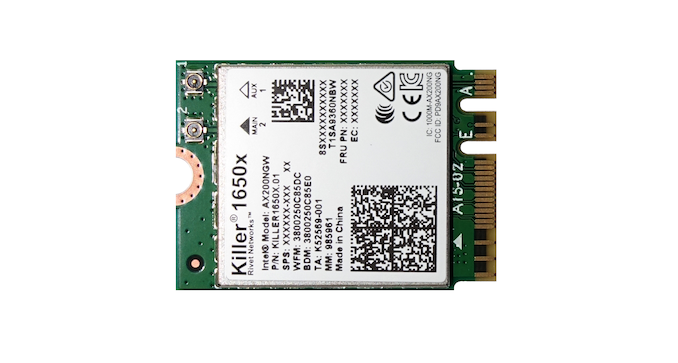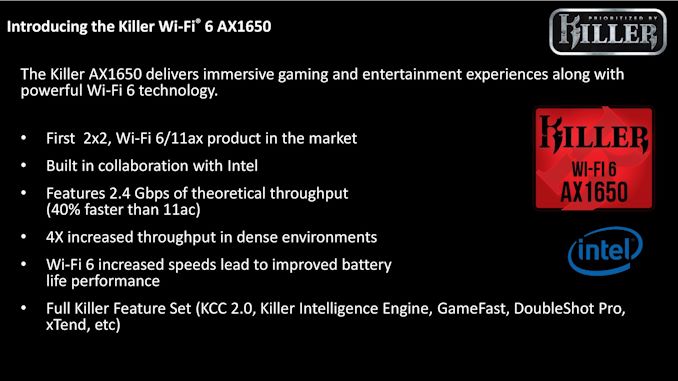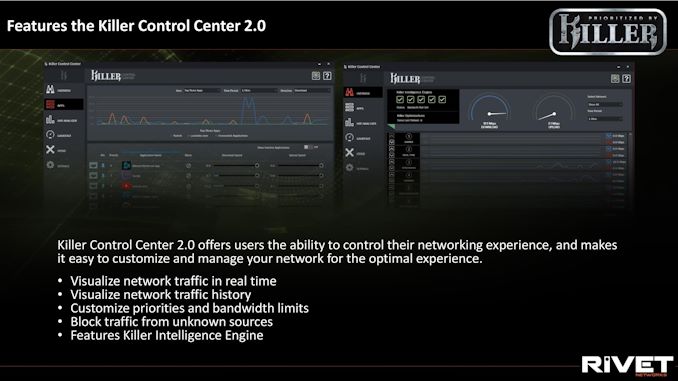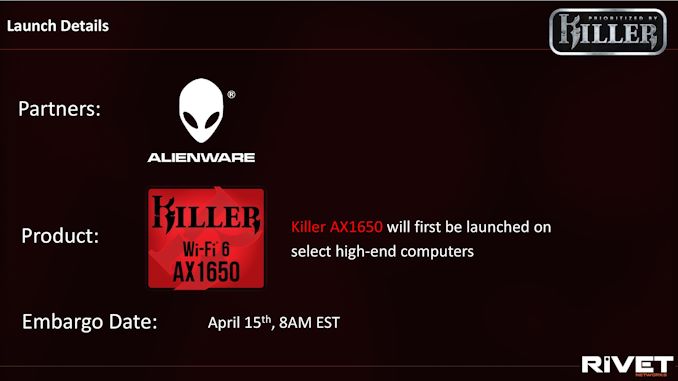The Killer AX1650: A Wi-Fi 6 Chip Built on Intel
by Ian Cutress on April 15, 2019 8:00 AM EST- Posted in
- Networking
- Intel
- Killer
- Rivet Networks
- Wi-Fi 6
- Killer AX1650
- 2x2

One of the core criticisms of the Killer networking hardware has been hardware reliability and drivers. On the last generation product, the company did away with those by working with Intel, using Intel hardware, and Intel’s driver stack. Intel’s part of the deal was to include the hardware and IP from the Killer team in order to enable Killer’s features: Advanced Stream Detection, the Killer Intelligence Engine, and prioritization. This launch is in collaboration with Intel again, for the Wi-Fi 6 enabled AX1650 chip, available for integration in devices or as an M.2 module.
Killer and Intel: A ‘Killer’ Combination for Wi-Fi 6
Intel recently announced its Wi-Fi 6 module, the AX200. The Rivet Networks Killer AX1650 is an evolution on this card, supporting the same features: up to 2.4 Gbps of theoretical throughput with a 2x2 connection better latency in multi-user scenarios, extended battery life in mobile devices, and sharing the same base driver stack. The Killer AX1650 promises to actually beat the Intel module to the market, and will be shipping in Alienware devices in April.
Wi-Fi 6 as a standard affords most of these benefits – up to 40% better performance over 802.11ac, increased throughput in dense environments, and a better race-to-sleep environment. The value add for the Killer version comes in its quality of service offering above and beyond what the Intel solution provides.
A Quick Recap on Killer: A New Killer
The company behind the Killer product line, Rivet Networks, spun out of Qualcomm’s Atheros division back in 2014 and has since built its latest technology with whichever partner can offer the best combination of features. For its Wi-Fi modules since 2017, this has been Intel, and that partnership is now in its second iteration. As mentioned above, Intel builds what Rivet needs into its base chip, and that chip is sold both as an Intel solution or a Killer solution with the added features enabled, but with the same hardware underneath and the same base driver stack, with additional tweaks on the Killer side.
Those tweaks enable the Killer product to do several things that the Intel version cannot: it uses trained algorithms to detect types of network traffic (streaming, gaming, VOIP, video, downloads) from the traffic patterns, and then calibrates the priority queue accordingly, ensuring that higher priority and latency sensitive traffic leaves the system first. The software automatically comes with a pre-programmed whitelist of software with auto-priority, and users can adjust the priority on the fly; Rivet also performs their own internal checks nightly to ensure those top 1000 applications are still detected properly. By offloading the network detection algorithms and prioritization process to the hardware, one of the promoted benefits of Killer is lower CPU use compared to other software-only optimization solutions.
What this means is that the two main problems users have with the Killer implementation, the hardware and the drivers, share the common backbone of Intel – without the Killer software installed, the hardware performs as the Intel solution should.
Additional Killer Features
Aside from the Advanced Stream Detect hardware/software integration, Rivet Networks has been building out the offerings that the company provides, all built using the underlying hardware as a point of acceleration. One of these is the Killer Intelligence Engine, which gives a list of optimizations that the software provides to give a cleaner networking experience, as well as recommendations that the user can do as well.
These optimizations include, for example, video stream detection being placed at low priority, or preferentially pushing traffic through different connections based on reliability, latency, and bandwidth. In speaking with Rivet Networks, the KIE has actually been a super tool for its customers in diagnosing networking issues.
Another prominent feature is xTend, which allows users to use the Wi-Fi module connected to a Wi-Fi network while also broadcasting as an access point. It uses time slicing to manage the two, but if users need to extend their network (say, in a restricted hotel room), then the Killer software can help manage this. For the AX1650 product, this means a full Wi-Fi 6 access point, allowing devices like the Samsung Galaxy S10 to take advantage of the connectivity features that Wi-Fi 6 provides.
For customers that want to integrate Killer into a laptop or onto a motherboard with multiple Killer connections (Wi-Fi plus wired), then the package also allows for Double Shot Pro, allowing users to configure which pipe data can go down, prioritizing for bandwidth and latency for users that can take advantage of multiple connections or networks.
We’ve actually been in contact with Rivet Networks for several years. One of the key highlights in discussing with them is that they are not afraid of feedback – they get a lot of it, as you might imagine. The team at Rivet has several times met with me over the years to discuss their hardware and software offerings, and I’ve seen the product line evolve over time, with some of my input making it into the final versions. There’s a lot of positivity in the team, and the genuine belief that they have a differentiating product that provides enthusiasts with substantial benefits to their gaming system. Being based on the Intel solution, the Killer product is a bit more expensive than Intel, and if it was no good, Rivet's partners wouldn’t continue using the product generation after generation. As an objectively neutral bystander, given I converse with all of Rivet’s competitors in a similar fashion, I can understand where the Killer product offerings do offer that level of differentiation compared to the competition, and compared to Intel’s solutions. OEMs like Dell, Acer, and MSI, all tend to agree for their gaming portfolio, and have been using the Killer solution for multiple generations.
The Killer Wi-Fi 6 AX1650 2x2
The first partner with Rivet Networks for the AX1650 is Dell’s Alienware, who will be shipping with the new chip in April. Given our conversations with vendors at CES, it looks like the Computex show in June is going to be a hub of a lot of new hardware, so we might expect to see additional announcements there. For users looking to buy the AX1650 separately for their system, an associated M.2 module will be available on Amazon in due course.
Related Reading:
- CES 2019: Rivet Networks Killer E3000, a 2.5 GbE Controller
- It’s Actually an Intel Chip: Rivet Networks Launches the Killer Wireless-AC 1550
- Rivet Networks Announces Killer xTend: Turning a Gaming PC into a Switch and Wi-Fi AP
- Rivet Networks Announces SmartByte for Dell Inspiron Systems
- Rivet Networks Launches the Killer E2500 Network Controller: Website Detection, New UI














32 Comments
View All Comments
khanikun - Monday, April 15, 2019 - link
I have the Killer E2500 on my Gigabyte Z370 board. It's never been able to get the 1 gbps it says its suppose to do. My other machines on the same switch can. New drivers, changed settings, checked, bios, swapped cables, nothing has made it do it's 1 gbps. I seem to only be able to get 100 mbps.Also their software is crap. I'll stay far away from any of these stupid Killer NIC things. I already have a router that can do all this stuff, I don't need a NIC that has it.
Personally, I think they should work on making 10 gbps nics and switches to help drive the prices down.
Ian Cutress - Monday, April 15, 2019 - link
That seems more like a motherboard routing issue - are you sure it's running at the full PCIe speed? How can you determine that it's the NIC causing the issue, rather than the motherboard?Besides, that's a wired connection, this is talking about wireless, which use the Intel driver stack. The Killer E3000 is their 2.5 GbE NIC, which doesn't use the Qualcomm Atheros stack the E2500 uses. The software works, not sure if you've tried the new software set. It went through a redesign, of which some of my input went into.
PeachNCream - Monday, April 15, 2019 - link
Very neutral of you to come to Rivet's defense so quickly. And it seems especially neutral to have design input on a given product that you claim to have no vested interest in. That smell - it's suspicious.Targon - Monday, April 15, 2019 - link
There are always people who end up with complaints because of network speed, and it often ends up being something that isn't the fault of the NIC. The last call I got on a similar issue was caused by a customer who connected their computer through their Polycom VOIP phone and only got 85Mbps even though the integrated network adapter was a 1Gbps NIC.Getting only 500Mbps MIGHT be the NIC, but under 100Mbps sounds like something else.
I will note that Ian sees a LOT of these sorts of complaints from monitoring these discussions, so it isn't defending the product in my opinion as it is that there are many reasons why someone might see sub-standard speeds. Look at the ethernet connection, is it showing that it is a 1Gbps connection?
khanikun - Tuesday, April 16, 2019 - link
Connected at 1 gbps is what Windows says, but transfers aren't going at those speeds. Swap ports on the switch, swapped cables with good cables, made new cables with my Cat 6 full copper cables, moved files around from hdd to ssds, to m2 ssd, etc to see if transfer speeds increase, swapped to a different switch, swapped to a different router, no change.Was going to try uninstalling the software, as someone else said it can cause issues. I'll be going to a PCIe nic. Going to reinstall Windows, but that's more due to changing up the hardware config of my comp.
f4tali - Monday, April 15, 2019 - link
"Very neutral of you to come to Rivet's defense so quickly. And it seems especially neutral to have design input on a given product that you claim to have no vested interest in."Who can blame him for wanting to roll in all Big Rivet Money? Not that I'm "defensing" him or anything...
f4tali - Monday, April 15, 2019 - link
Yeah, yeah... I should have known better than to try and correct grammar on a site without an edit option.Ian Cutress - Monday, April 15, 2019 - link
As with Intel, as with AMD, I've spent time with these guys (and their competitors) going over product portfolios and underlying technologies, as well as integration through to driver/software and ultimately public presence.I see a lot of gut reaction to any new Killer product. Most of that vitriol is based on older products under previous management, completely unrelated to the new product only by virtue of the brand name. Only with the Killer brand do I have to retell the story of what it was and what it is today - this only happens to Killer, because users are hung up on previous interactions with the brand when it was under Qualcomm. Under QC, there was limited investment and limited product development. That has changed very rapidly recently, and the company is growing, and more OEMs are interested in the new featuresets offered by the products. But still people harp on about the old stuff, or they have had isolated incidents on semi-old stuff, which is mostly unrelated to the new stuff.
PeachNCream - Monday, April 15, 2019 - link
If you can post numbers that show Rivet Network's software makes a difference, then that would help your case greatly. This isn't only about prior failures. The company in the present time is offering a more expensive product without a proven benefit. Anandtech has not tested a Killer NIC's performance claims in a literal decade. Meanwhile, its employees continue to champion the company (you, Ian, in particular have stood by them without evidence since 2016). How is that neutral and what benefit does it offer to readers to leap into comments to protect the brand without the publication of any meaningful numbers?khanikun - Tuesday, April 16, 2019 - link
I personally never paid much attention to Killer products. All I know was when they first came out, they were way expensive and had features I'd never use. So, didn't really care too much what they did.This is the second time I've had anything Killer. I had a Killer wifi in my Alienware laptop, that I never used, so no comment on that. Now I have this on my mobo and no other nic, so stuck using it and having issues. Nothing really changes on my thoughts on Killer. I'll swap to a different nic and not pay attention to them.